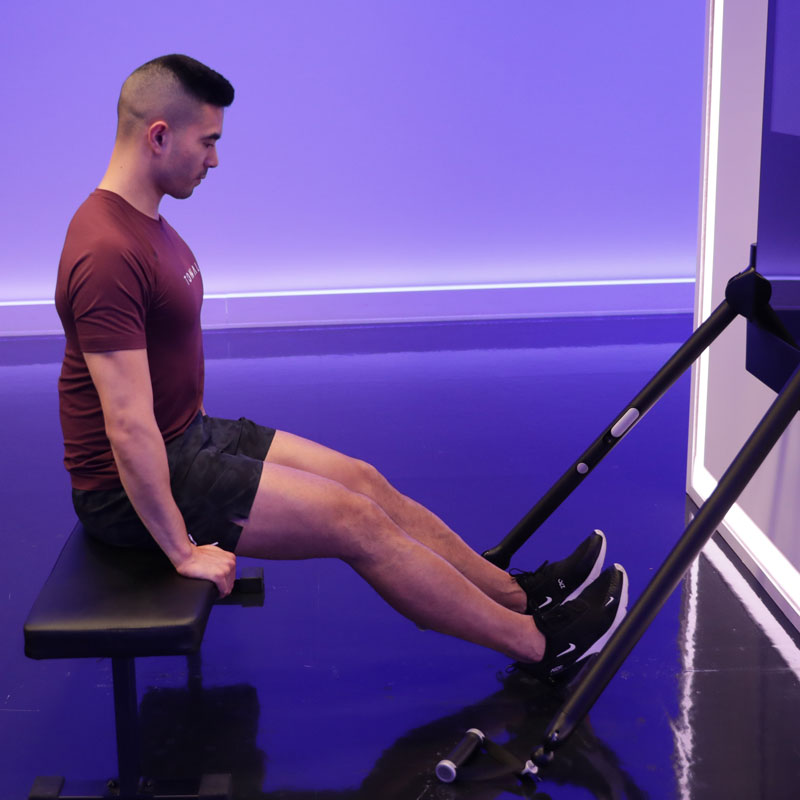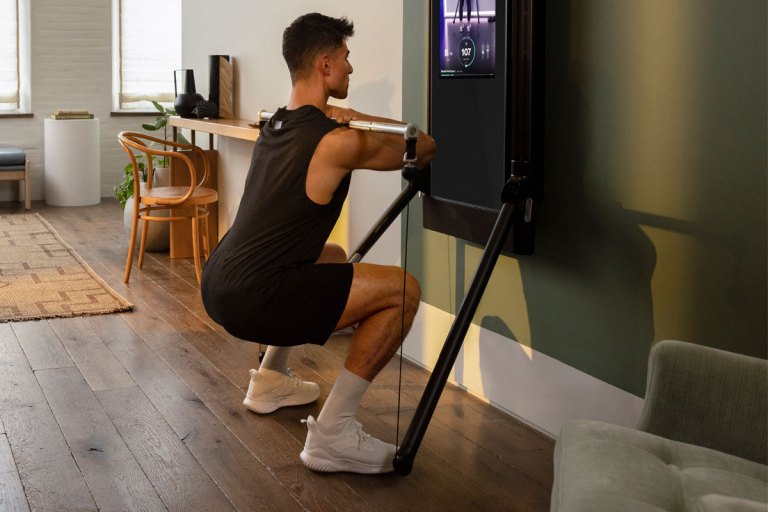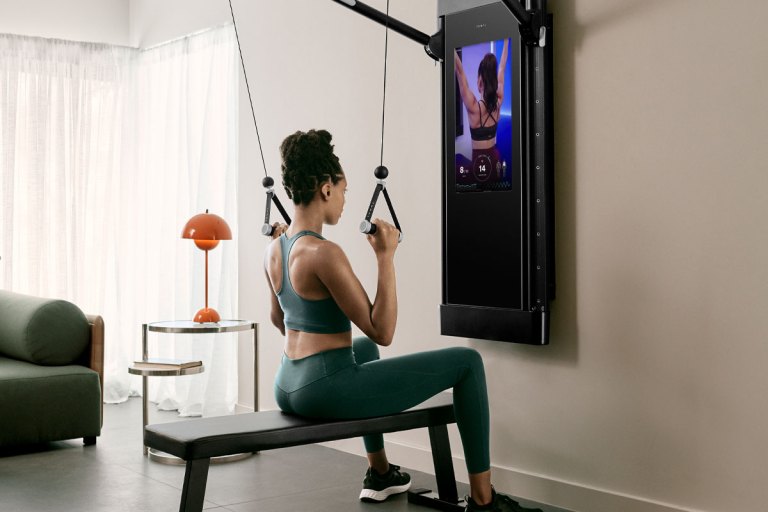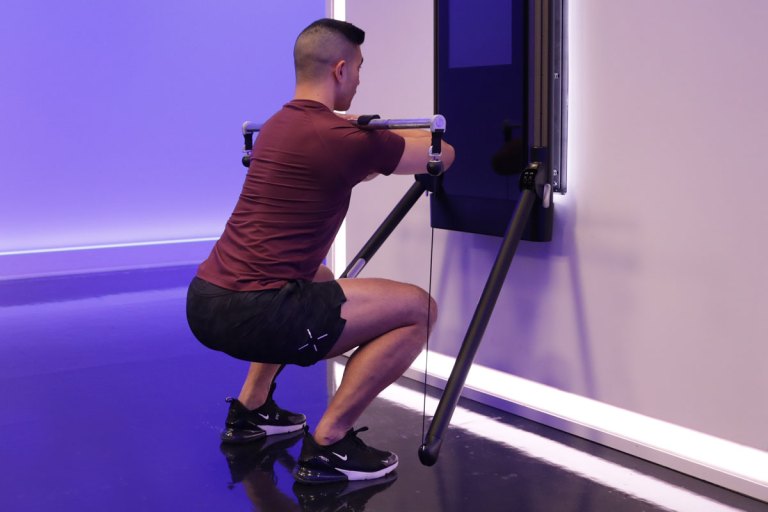Hate Bulgarian Split Squats? Try These 5 Tips
Get all the leg-strengthening, balance-boosting benefits of this challenging exercise. You might even learn to love it.

As essential as lower-body strength is for well-rounded fitness, sports performance, and everyday activities, too many exercisers are still skipping leg day. Of the Tonal members surveyed in the 2023 State of Strength report, 52 percent said lower-body workouts were their least favorite. For Tonal members, one reason for shortchanging lower-body work is the dislike of one move in particular: the Bulgarian split squat.
Peruse the Official Tonal Community on Facebook, and you’ll find all sorts of colorful language used to describe this move. From the understated “not my favorite” to “diabolical,” “dreaded,” and “awful,” members have no shortage of ways to express how much they love to hate Bulgarian split squats. Despite its notoriety, the Bulgarian split squat is actually the fifth most popular lower-body move on Tonal, according to the State of Strength report, reflecting how frequently this move is programmed into workouts–and for good reason.
Even though it may seem like it, Tonal’s performance experts and world-class coaches don’t add Bulgarian split squats into workouts and programs just to torture you. They frequently include them because they’re incredibly effective at strengthening your glutes, quads, and hamstrings. Additionally, the split stance of this move builds your balance and stability by working the small stabilizer muscles in your hips, feet, and ankles, according to Tonal coach and certified personal trainer Tim Landicho.
“It’s such a good bang-for-your-buck move,” says Landicho. “If you’re a little time-crunched, it’s a great way to get as many muscles involved as possible with that compound movement pattern, while also kicking on all the stabilizers.”
What Are Bulgarian Split Squats?
For the uninitiated, the Bulgarian split squat takes a standard, staggered-leg split squat to the next level (literally) by having you elevate your back leg on the bench.
Along with working your glute and leg muscles, the Bulgarian split squat challenges your balance and stability due to its unilateral nature. By addressing asymmetries between sides, this single-leg move can also ultimately help you lift heavier in your bilateral squats. Building strength in this movement pattern can improve your running, walking, and sprinting, according to Landicho.
Despite its names, the actual origin of the Bulgarian split squat is somewhat murky. While the move was popularized by Angel Spassov, assistant coach of the Bulgarian weightlifting national team, during his tour of the U.S. in the 1980s, other Bulgarian weightlifters and their coaches have since claimed that the exercise was never part of their training. Still, the name stuck.
Bulgarian Split Squat

How to Do it: Place one foot between Tonal’s arms and reach your opposite leg back, placing the top of the foot on the bench. Hold the handles and stand tall. Keeping your front heel down like it’s glued to the floor, bend both knees to drop your hips down until your front thigh is parallel with the floor. Press the floor away from you to stand and repeat on the same side
Why Are Bulgarian Split Squats So Hard?
If you’re struggling with Bulgarian split squats, it’s important to know that you’re not alone. This move is geared toward intermediate and advanced lifters and, as Landicho explains, it does require a bit of proficiency before you can start seeing the benefits.
One reason this move is so difficult is that the position puts the majority of your weight onto your front leg, a position that requires balance and stability. “It truly does start to become a single-leg variation,” says Landicho. In a split squat with both feet on the ground, you’re able to put more weight on your back foot, which makes it easier to balance.
Elevating your back foot on the bench in a Bulgarian split squat also allows your back knee to travel lower toward the ground, which demands a greater range of motion. Any mobility limitations in your hips, knees, or ankles can make the move even more challenging. “It really doubles as a mobility exercise,” says Landicho.
How to Stop Dreading Bulgarian Split Squats
Even though they’re challenging to get right, you don’t have to fear or avoid Bulgarian split squats. Try these tips to make the move one you actually look forward to doing on Tonal:
1. Work Your Way Up
You wouldn’t kick off a new running habit by racing a marathon, so don’t feel like you need to tackle Bulgarian split squats right away if you’re new to strength training or new to Tonal. Before attempting Bulgarian split squats, Landicho recommends developing your confidence and competency in a series of similar moves.
Take your time working through this progression of unilateral, lower-body exercises, only moving on once you feel confident that you can do each exercise with solid form. Landicho recommends learning the bodyweight version of each move before progressing to the weighted variation so that you have an immediate reference point to how a movement should feel before adding resistance. Through this progression, you’ll practice balance, mobility, and other skills you’ll need to nail Bulgarian split squats.
- Bodyweight Split Squat
- Split Squat
- Bodyweight Alternating Reverse Lunge
- Racked Reverse Lunge
- Bodyweight Bulgarian Split Squat
- Bulgarian Split Squat
2. Warm Up with Mobility Moves
Since Bulgarian split squats require a wide range of motion in the quads and hip flexors, Landicho suggests adding mobility moves that target those areas into your routine. Try these exercises as a warmup before a workout featuring Bulgarian split squats, or practice them a few times per week to build mobility.
Quad Hip Stretch

Why it Works: This simple stretch promotes hip flexion, which will help you go deeper in Bulgarian splits. To make it more challenging, lift your back foot and rest it on the bench.
How to Do it: Start in a half-kneeling position on your mat. With the arm that’s opposite the front leg, reach up and forward like you’re trying to touch the ceiling, rotating at your torso and shifting your weight forward as you twist toward the front leg.
Runners Lunge

Why it Works: Landicho likes this stretch for targeting the anterior, or front side, of your legs and hips.
How to Do it: Get into a low lunge position with your front foot planted and your back leg extended behind you, with your knee on the floor and toes tucked. Place your hands on the floor inside the front leg, shoulder-width apart. Lift your back knee slowly to straighten your back leg and lift the back of the knee toward the ceiling. Relax your knee back down to the floor and repeat.
3. Lock in Your Bulgarian Split Squat Form
Optimizing your Bulgarian split squats form and starting position can set you up for success with this move. “Keep your front heel in contact with the ground the entire time, and your ribcage and pelvis stacked and locked in,” says Landicho. “If your connection to the ground isn’t there, everything upstream is going to suffer.”
He explains that a common mistake is standing too far or too close to the bench. To find the right position for you, sit at the edge of your bench with your legs extended. Take a look at where your heels land in this position: That’s where your front foot should be placed at the start of the move. You’ll know that your front foot is too close to the bench if you can’t keep that heel planted on the ground as you complete the rep. If you start to feel too much extension through the spine, and can’t maintain tension in your core, the bench may be too far away.

4. Modify to Make it Work
Depending on your personal body mechanics and range of motion, you might have to make small modifications to make Bulgarian split squats work for you. You’ll still get all the benefits of the move but feel more comfortable in the process.
First, try replacing the bench with a stable surface that’s a few inches shorter. “The higher that back foot is elevated, the more hip and knee mobility, especially of the back leg, is required,” says Landicho, adding that lowering the back foot also takes some of the load off your front leg. As you get stronger, you can gradually increase the height of the surface.
Next, focus on working in a range of motion that you can control, even if this means you aren’t getting as low as the coaches on screen. “Spend time getting strong there,” says Landicho. “Finding the edge of your capacity and challenging that over time will start to create a structural change in the mobility of that back leg so that you can reach lower and lower depths.”
5. Shift Your Mindset
Even if you have the strength and movement competency to perform a perfect Bulgarian split squat, there could still be a mental block holding you back from embracing this notorious move. If this is the case, your solution could be as simple as shifting your perspective. Approach the Bulgarian split squat as a challenge that’ll ultimately make you stronger instead of something you fear.
“Stretching the limits of your comfort zone is the point of training,” says Landicho. “The only way to raise your performance is by consistently pushing the edges of your physiology.” As long as the move is uncomfortable but not painful, he recommends acknowledging the discomfort and tying that back to your ultimate goal.
Ultimately, though, your workout should work for you and not the other way around. If you’ve tried all of the above and Bulgarian split squats are still causing you pain, use Tonal’s movement replacement feature to swap in a different exercise, such as the bodyweight version, the basic split squat, or another unilateral squat or lunge variation, such as the racked reverse lunge.


